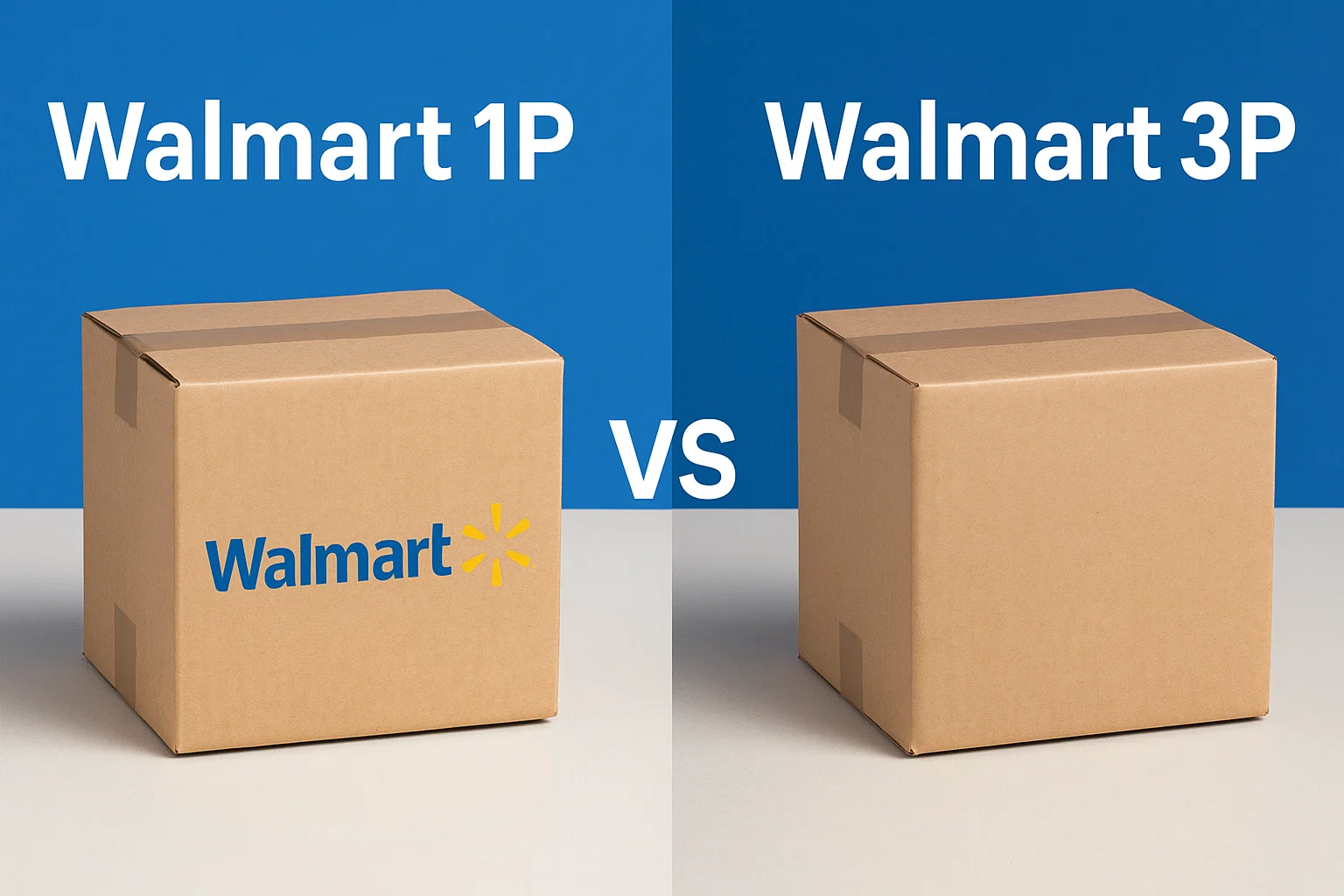As Walmart rapidly expands its online marketplace, more sellers are exploring opportunities to list their products and reach millions of customers. But before diving in, there’s an essential decision every seller must make: Walmart 1P vs 3P — which selling model is the right fit for your business?
These two models offer drastically different experiences. With Walmart 1P (First-Party), you operate more like a supplier, selling your products wholesale directly to Walmart. In contrast, with Walmart 3P (Third-Party), you list your products on the Walmart marketplace, maintain control over pricing, fulfillment, and branding, and sell directly to customers.
Choosing between the Walmart 1P and 3P model is a critical step that impacts your brand visibility, profit margins, logistics, and overall strategy. This guide will break down the key differences, pros and cons, costs, and use cases of both models — helping you make an informed decision aligned with your goals.
Whether you’re a large manufacturer or a small eCommerce brand, this comprehensive guide to Walmart 1P vs 3P will help you unlock the best path to success on Walmart’s booming online platform.
What is Walmart 1P (First-Party)?
Walmart 1P (First-Party) is a wholesale relationship where you, the seller, act as a supplier selling your products directly to Walmart. In this model, Walmart purchases inventory from you and then takes on the responsibility of selling those products under its own brand, either online or in stores.
Think of it like this: You ship bulk products to Walmart’s distribution centers, and Walmart handles pricing, customer service, shipping, and promotions.
How Walmart 1P Works:
You enter into a wholesale agreement with Walmart.
Walmart issues a purchase order for products they want to stock.
You ship products in bulk to Walmart’s designated locations.
Walmart sets the retail prices and sells to customers.
Key Features:
Walmart is the retailer of record, not your brand.
Pricing and marketing control is minimal; Walmart decides how products are priced and promoted.
Products are often featured more prominently on Walmart.com and may be stocked in physical stores.
Who Should Use Walmart 1P?
This model is best suited for:
Large manufacturers and brands that produce in high volume.
Suppliers with established logistics and the capacity to fulfill large bulk orders.
Businesses seeking mass exposure through Walmart stores and online presence.
Advantages of Walmart 1p:
One of the most significant benefits of joining Walmart as a 1P supplier is that the retail giant takes over the heavy lifting. Once Walmart places a bulk purchase order, they handle pricing, fulfillment, returns, and customer support—freeing you from daily operational tasks. This can be ideal for manufacturers or wholesalers who prefer to offload the selling process and focus on production or backend logistics.
Another major advantage is the credibility and exposure that comes with the Walmart name. When your products are marked “Sold & Shipped by Walmart,” customers are more likely to trust and purchase them, leading to higher conversion rates. Plus, Walmart tends to prioritize 1P listings in search results and marketing campaigns, both online and in physical stores. This leads to enhanced visibility and better shelf positioning without requiring you to invest in additional promotions. Additionally, by operating like a traditional wholesale model, you don’t have to worry about individual order processing or managing third-party platforms, which simplifies operations at scale.
Disadvantages of Walmart 1p:
However, the Walmart 1P model comes with limitations—chief among them is a lack of control. Walmart dictates pricing, and to stay competitive, they may lower your product prices, even if it cuts into your margins. This can create conflicts if you’re also selling on other platforms like Amazon, which penalizes price disparities. You also don’t have authority over your product’s branding, descriptions, or packaging, which may lead to inconsistencies across sales channels and weaken brand identity.
Another concern is that once Walmart purchases your inventory, it becomes their responsibility—but also their decision. They can stop placing purchase orders without warning, which can leave you with unsold stock or disrupt cash flow. Sellers reliant on this model may find it challenging to scale sustainably without diversifying their sales channels. And because you’re selling at wholesale prices, your per-unit profit is typically lower than if you sold directly to consumers.
If you’re just starting out with Walmart, check out our detailed guide to learn how to sell products to Walmart.
What is Walmart 3P (Third-Party)?
Walmart 3P, or third-party selling, allows independent sellers to list and sell their products directly to consumers on Walmart Marketplace. Unlike the 1P model, where Walmart purchases inventory from a supplier and handles the sales, 3P sellers retain full ownership of their products and operate more like a traditional eCommerce business within Walmart’s ecosystem.
As a 3P seller, you’re responsible for listing, pricing, inventory management, order fulfillment, shipping, and customer service—unless you choose to partner with Walmart Fulfillment Services (WFS), Walmart’s in-house logistics option. This setup offers more flexibility, freedom, and control over your business operations, product branding, and profitability.
Walmart 3P has become increasingly popular, especially among small to medium-sized eCommerce businesses, private label brands, and dropshippers. The barrier to entry is lower compared to Walmart 1P, and the marketplace continues to expand, offering access to Walmart’s massive customer base—over 120 million unique monthly visitors in the U.S. alone.
With Walmart Marketplace, sellers can also take advantage of integrations with leading eCommerce platforms (like Shopify, BigCommerce, and Deliverr) and advanced advertising tools like Sponsored Products. While the competition is growing, the model provides long-term scalability and direct access to customer insights and data.
Walmart 3P Advantages
One of the biggest advantages of selling on Walmart as a 3P seller is the level of control you retain over your business. You can set your own prices, manage your inventory, create your product listings, and control your branding. This flexibility is a huge plus for brands that want to maintain consistency across platforms or those that sell on Amazon, Shopify, or their own websites. It also means you can test different pricing strategies and optimize listings without relying on Walmart’s retail teams.
Another benefit is the potential for higher profit margins. Since you’re selling directly to customers rather than wholesaling your products to Walmart, you’re not locked into wholesale pricing. You collect the full retail amount (minus seller fees), which allows for greater profitability—especially if you’re selling niche or premium products. You can also opt to use Walmart Fulfillment Services (WFS), which simplifies logistics and improves delivery speeds, all while qualifying your products for “2-day shipping” badges that increase visibility.
Finally, Walmart Marketplace offers exposure to a massive audience with relatively low competition compared to Amazon. There are fewer sellers on Walmart’s platform, meaning there’s more opportunity to stand out, especially if your product is unique, well-reviewed, and competitively priced. Combined with built-in ad tools like Sponsored Products, this gives you a fair chance to scale your store and build a loyal customer base.
Walmart 3P Disadvantages
Despite the freedom, being a Walmart 3P seller comes with challenges. You’re responsible for everything—from creating optimized listings and handling customer inquiries to managing shipping and returns. If you’re not using WFS, logistics can become complicated and impact delivery speed, which affects your seller performance metrics. Failure to meet Walmart’s performance standards (like order defect rates or late shipment rates) can result in deactivation of listings or even account suspension.
Another downside is that 3P sellers don’t benefit from the same trust factor that Walmart 1P products do. While 1P listings are labeled “Sold & Shipped by Walmart,” 3P sellers appear with their own store name, which can affect customer trust—especially for new or unfamiliar brands. You’ll need to work harder to earn reviews, build credibility, and provide top-notch customer service.
Lastly, even though listing on Walmart is free, the onboarding process can be lengthy. Walmart is selective about who it allows on the marketplace, often requiring a proven sales history, existing fulfillment infrastructure, and strong customer service track record. Getting approved can take weeks, and if you don’t meet their standards, your application may be rejected.
A Seller’s Guide to Walmart’s Private Label Trends in 2025
Walmart 1P vs 3P: Key Differences and Which One is Better for You?
Choosing between Walmart 1P (first-party) and 3P (third-party marketplace) selling models depends entirely on your business goals, resources, and how much control you want over your operations. Let’s break down the core differences and help you decide which model fits your brand best.
Control and Ownership
Walmart 1P sellers give up most of the control to Walmart. You sell your products in bulk to Walmart, and they become the retailer. Walmart controls pricing, promotions, inventory levels, product pages, and customer service.
Walmart 3P sellers retain full ownership of their listings and inventory. You control pricing, shipping (unless using WFS), branding, and how your product is marketed. It’s ideal for businesses that want to maintain their brand image.
Revenue Model and Profit Margins
1P sellers are paid wholesale prices, meaning lower margins. Walmart determines your pricing, and their margin comes off the top.
3P sellers earn the full retail amount (minus commission and fulfillment fees), often resulting in higher profit margins. However, more effort is required in managing the storefront and logistics.
Logistics and Fulfillment
1P sellers ship bulk inventory to Walmart’s warehouses. From there, Walmart handles delivery to the customer.
3P sellers must fulfill individual orders unless they enroll in Walmart Fulfillment Services (WFS). This gives you Amazon-like fulfillment benefits with fast shipping and trust badges.
Branding and Customer Trust
1P products benefit from Walmart’s brand recognition. Items appear as “Sold & Shipped by Walmart,” which builds trust instantly.
3P products display the seller’s brand. New sellers may struggle initially to establish trust and credibility, especially without reviews or recognizable branding.
Walmart 1P vs 3P: Which Selling Model is Right for You?
Choosing between Walmart 1P and 3P depends entirely on your business goals, your operational capacity, and how much control you want over your brand.
Walmart 1P is ideal if you prefer a wholesale business model. You sell your inventory in bulk to Walmart, and they take care of everything else—from pricing and shipping to customer service. This model is hassle-free and convenient for businesses that want guaranteed volume, don’t want to handle fulfillment, and are okay with handing over control to a major retailer.
On the other hand, Walmart 3P gives you the ability to sell directly to customers via Walmart’s Marketplace. You maintain control over your pricing, inventory, product content, and brand presence. This model is more flexible and allows for higher profit margins—especially if you’re managing fulfillment efficiently or using Walmart Fulfillment Services (WFS).
So, how should you decide?
Choose Walmart 1P if:
You’re looking for a bulk purchase model
You don’t want to manage logistics or customer service
You’re okay with Walmart controlling pricing and product messaging
Choose Walmart 3P if:
You want full control of your brand and pricing
You’re aiming for higher margins through direct-to-consumer sales
You’re focused on growing your business and customer base over time
In summary, Walmart 1P is great for wholesale simplicity, while Walmart 3P is better for brand control and growth. Many businesses even explore both options based on the product type or stage of growth.
Discover which products perform best on Walmart Marketplace by checking out our guide on Walmart Best Selling Items: Top Products to Sell! Boost your sales with trending, high-demand items.
Walmart 1P vs 3P: FAQ's
What’s the main difference between Walmart 1P and 3P?
Walmart 1P involves selling your products wholesale to Walmart, which then sells to customers. In 3P, you list and sell your products directly to customers via the Walmart Marketplace.
Is Walmart 1P or 3P better?
It depends on your business goals. Walmart 1P is ideal if you prefer wholesale operations and want Walmart to handle logistics, pricing, and customer service. Walmart 3P is better if you want more control over your brand, pricing, and customer experience. Many sellers choose 3P to grow their business independently, while 1P offers scale with less day-to-day management. Choose the model that aligns best with your growth strategy and resources.
Is Walmart 3P better for small businesses?
Yes, 3P is often better suited for small to mid-sized sellers who want full control over pricing, listings, branding, and fulfillment. It offers greater flexibility and potentially higher profit margins than the 1P model.
Walmart 1p vs 3p: Final Thoughts
Deciding between Walmart 1P and 3P comes down to how much control you want over your pricing, branding, and operations. If you’re looking for a hands-off, wholesale-style relationship with Walmart, 1P might be the better fit. However, if you’re focused on long-term brand growth, customer engagement, and maximizing profit margins, 3P provides the flexibility and freedom to build your business your way.
Ultimately, both models have their strengths. Sellers often choose 3P to start because it offers more control and scalability, then explore 1P as they expand. Evaluate your goals, resources, and risk tolerance carefully before deciding.
Contact Us for Tailored Solutions – Stores Automation:
Ready to transform your Walmart store and achieve big wins? Contact us at Stores Automation for personalized solutions that leverage the power of automation for your business. Reach out to us at 302-204-8244 or via email at info@storesautomation.com. Sign up and Embark on the path to e-commerce success with Stores Automation – where small changes lead to big wins!





